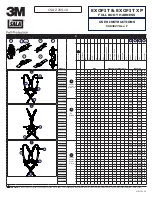
PWM CV:
Control Voltage input determining the duty cycle of the Pulse output in conjunction with the
“Pulse Width” knob. The full Pulse Width “window” can be spanned with an input range of 10V with the
“Pulse Width” knob at Full CW, or bipolar voltage can be used with the “Pulse Width” knob adjusted
further clockwise.
Saw/Ramp Switch:
Selects the waveform present at the “Saw/Ramp” output jack. The upper position will
produce a waveform which starts at +2.5V and linearly decreases to -2.5V before resetting, while the
lower position will produce the opposite.
Saw/Ramp:
Output for the Saw or Ramp waveform, depending on the position of the Saw/Ramp switch.
Pulse:
Output for the Pulse waveform, produced by a comparator on the Triangle wave.
Triangle:
Output for the Triangle waveform.
Complex:
Output for the Complex waveform. This waveform is a phase-inverted version of the Triangle
waveform put through a “Lockhart Wavefolder” as demonstrated in the article "Nonselective Frequency
Tripler Uses Transistor Saturation Characteristics" by R. Lockhart, Jr. and perfected by Catgirl Synth as
CGS52.
4. Patch Ideas
"Stepped LFO"
Set Range switch to “Super Lo” range and Coarse knob full CCW. Feed a Gate input into the Expo FM
and adjust the level to taste. While the Gate is high, the LFO will move somewhat rapidly, while with the
Gate low it will hold relatively steady, producing a “Staircase” in the shape of the nominal waveform
output.
“Self Control”
Patch the Complex waveform output into the Lin FM input for a crazy FM-like sound in the “Hi” frequency
range.
“Enveloped Pulses”
Turn the “Pulse Width” knob full CW and feed a 0-5V envelope such as the output from a DUSG into the
“Pulse Width” input. This will cause the Pulse output to be muted at 0V input all the way up to 50% duty
cycle at 5V input.
These are but three patch ideas, and a thorough exploration of the Rottnest can surely yield many more.





















